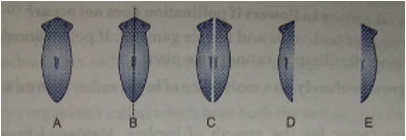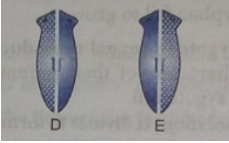Short Answer Questions - I - 2 Marks
Que 1. Reproduction is essentially a phenomenon that is not for survival of an individual but for continuation of a species. Justify.
Ans. For survival, an individual needs energy which it obtains from life processes such as nutrition and respiration. Reproduction does not provide energy for survival. Instead, reproduction ensures transfer of genetic material from one generation to the next which helps in continuation of species. Hence, it is an important phenomenon for maintaining continuity of species.
Que 2. Define the terms unisexual and bisexual giving one example of each.
Ans. Unisexual: In most of the animals including humans, male and female reproductive organs are in different individuals. Such animals are called unisexual.
Bisexual: In some animals like tapeworm, liver fluke, earthworm, leech, etc., the male and female reproductive organs are found in a single individual. Such organisms are called bisexual (hermaphrodite).
The flower may be unisexual (e.g., papaya, watermelon) when it contains either stamens or carpels and bisexual (e.g., Hibiscus, mustard) when it contains both stamens and carpels.
Que 3. What is a clone? Why do offsprings formed by sexual reproduction exhibit remarkable similarity?
Ans. Clone refers to offspring of an organism formed by asexual method of reproduction. Since they possess exact copies of the DNA of their parent, clones exhibit remarkable similarity.
Que 4. Why cannot fertilisation take place in flowers if pollination does not occur?
Ans. In a flower fertilisation requires both male and female gametes. If pollination does not occur, male gamete is not available hence fertilisation cannot take place.
Que 5. Why does bread mould grow profusely on a moist slice of bread rather than on a dry slice of bread?
Ans. Moisture is an important factor for the growth of hyphae. Moistened bread slice offers both moisture and nutrients to the bread mould, hence it grows profusely, Dry slice of bread offers nutrients but not moisture hence hyphae fail to grow.
Que 6. Explain the roles of gametes and zygote in sexual reproduction.
Ans. The two fusing gametes possess characters of their parents in their DNA. Fertilisation brings characters of both parents into one zygote cell.
Zygote is the first cell of the next generation. It divides to form an embryo which subsequently grows into a new individual.
Male gamete forming part - anther/stamen
Female gamete forming part - pistil/ovary/ovule
Que 7. Describe the structure of a pollen grain.
Ans. Stamens produce pollen grains that are yellowish in colour. Pollen grain is unicellular and haploid. It has two layers, the thicker outer one is called exine, which is thin at places called germ pores and inner thin layer is called intine.
Que 8 In a germinating seed, which parts are known as future shoot and future root? Mention the function of cotyledon.
Ans. In a germinating seed, plumule in known as future shoot and radicle is known as future root. The function of cotyledon is to store food for the future plant or embryo.
Que 9. Identify the following parts of a flower:
(i) Part that produces pollen grain.
(ii) Part that transfers male gametes.
(iii) Part that is sticky to trap.
(iv) Part that develops into a fruit.
Ans. (i) Anther (ii) Style (iii) Stigma (iv) Ovary
Que 10. What is puberty?
Ans. The period of adolescence when the reproductive organs become functional, is termed as puberty. It is accompanied by development of secondary sexual characters both in males and females.
Que 11. Differentiate between self-pollination and cross-pollination
Ans.
|
Self-Pollination |
Cross-Pollination |
|
1. Transfer of pollen grains from anthers to the stigma of the same flower or another flower of the same plant. |
1. Transfer of pollen grains from anthers of a flower to the stigma of another flower borne on another plant of the same species. 2. It occurs in unisexual as well as in bisexual flower, e.g., maize |
Que 12. Give two reasons for the appearance of variations among the progeny formed by sexual reproduction.
Ans. (a) Sexual reproduction involves two parents with different sets of characters.
(b) The gene combinations are different in gametes.
Que 13. Would a Planaria cut vertically into two halves regenerate into two individuals? Complete Figure D and E by indicating the regenerated regions.

Ans. Yes, shaded part in Figures D and E represent the regenerated halves.

Que 14. What are the benefits of using mechanical barriers during sexual act?
Ans. Mechanical barriers like condom prevent the sperms from reaching the egg. Thus it is an effective method to avoid pregnancy. It also prevents transmission of infections during sexual act.
Que 15. Write one main difference between asexual and sexual mode of reproduction. Which species is likely to have comparatively better chances of survival-the one reproducing asexually or the one reproducing sexually? Justify your answer.
Ans. Asexual reproduction does not involve genetic fusion while sexual reproduction involves fusion of male and female gametes to form a zygote.
Species reproducing sexually have better chances of survival. This is because sexual reproduction gives rise to more variations which are essential for evolution as well as survival of species under unfavorable conditions.
Que 16. Why is DNA copying an essential part of the process of reproduction? What are the advantages of sexual reproduction over asexual reproduction?
Ans. DNA copying is essential because it makes the transmission of characters from parents to the next generation possible.
Advantages of sexual reproduction over asexual reproduction:
sexual reproduction gives rise to variations, which are essential for evolution as well as for survival of species under unfavorable conditions.
Que 17. Trace the path of sperm during ejaculation and mention the gland and their functions associated with the male reproductive system.
Ans. Sperm comes out from testis into the vas deferens and then passes through urethra before ejaculation. The secretions of seminal vesicle and prostate glands provide nutrition to the sperms and also facilitate their transport.
Que 18. Give two reasons for avoiding frequent pregnancies by women.
Ans. Frequent pregnancies by women are avoided due to the following reasons
(i) It has adverse effect on the health of women
(ii) It increases the rate of the population of our country.

